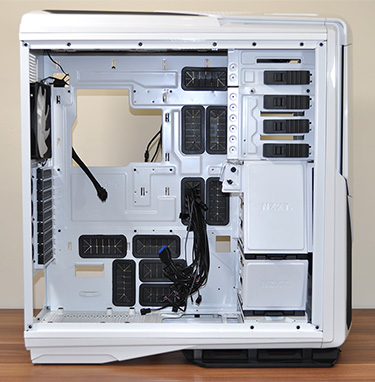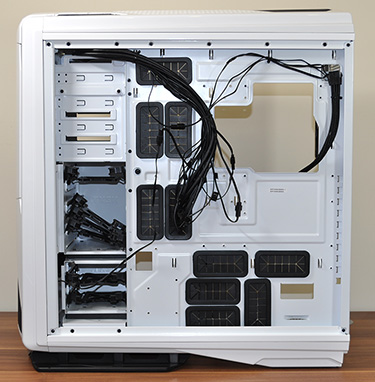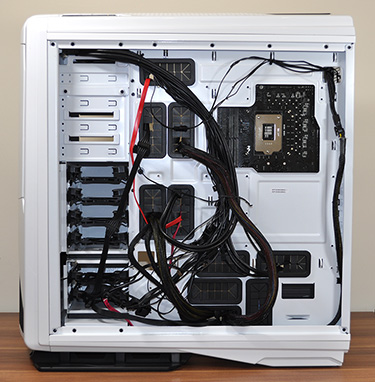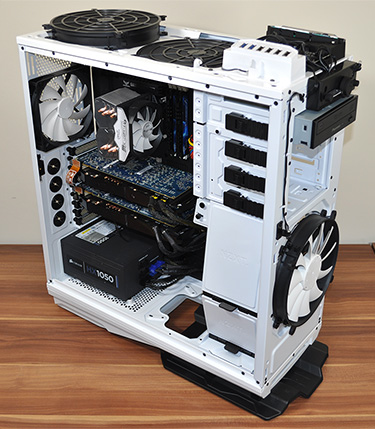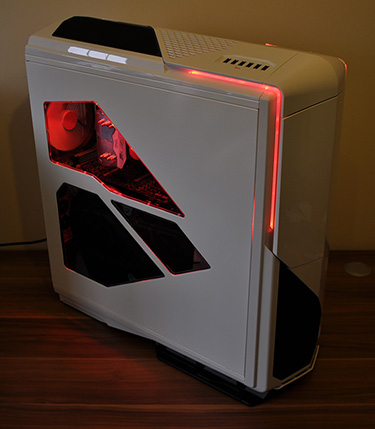Inside the Phantom 820
They don't come much more inviting than that, do they? NZXT's full-tower frame is extremely spacious throughout and the white-and-black colour scheme looks attractive.
Straight away, we can see that cable-routing shouldn't be a problem. The Phantom 820 includes 10 rubber-grommeted holes, plenty of tie-down points, and an up-and-over hole for the CPU power cable. NZXT includes an eight-pin extension cable for the latter, making it easy to route the CPU power connector to the top of any installed motherboard, however the cabling around the back of the motherboard tray isn't as tidy as it might have been. The main reason for this is the integrated four-channel fan controller; there are so many available headers that the pre-installed cables look quite messy.
In keeping with the chassis' exterior, the interior cavern is also stocked full of interesting features. The rear exhaust fan, for example, can be moved up or down to align it with your CPU cooler. A pivoted fan mount on the side of the upper hard-disk cage is positioned to direct air toward your hot-running components, and the lower cage (providing two of the six available hard-disk bays) can be removed to make way for a bottom-mounted radiator.
NZXT's overall layout is excellent and highly configurable, but it isn't quite perfect and there are a couple of areas that could be improved. The 3.5/2.5in drive trays are our biggest bugbear, as they're flimsy and awkward to lock into place securely. They feel as though they're always on the verge of falling out, and they also face the rear of the chassis so you'll need to remove the rear side panel before adding/removing drives.
Another potential issue around back is the 20mm clearance for excess cables. The protrusion in the side panel provides a little more room, of course, but for a chassis of this size the void behind the motherboard tray seems unnecessarily narrow. Or perhaps it's not the space that's the issue, maybe it's the number of pre-installed cables. With all the USB headers, an SD card slot and many, many fan cables, the Phantom 820 needs a fair amount of tidying before it begins to look neat.
And nitpicking somewhat, each side panel is held in place by three thumb screws; it feels a chore having to open them all up and it doesn't help that the side 200mm intake fan isn't hardwired into the chassis, leaving a trailing cable whenever you remove the panel. Minor complaints again, but we'd have much preferred a single push-to-release button, à la Corsair's Obsidian 800D.
Nitpicking is the key word, though, as the Phantom 820 is, for the most part, extremely easy to build into. There's enough room to conjure up a super-extreme rig, and NZXT has covered almost every base. Got lots of fans? A couple of radiators? Multiple graphics cards? Numerous hard disks? An ultra-long PSU? A large E-ATX motherboard? No problem, the Phantom 820 will gobble all that up without kicking up a fuss.
We're not usually fans of LED-illuminated PC chassis, but NZXT's implementation does work well. The strips of light are in all the right places, and, more importantly, users have good control over lighting zones, colour and the ability to turn the lights on/off completely.






